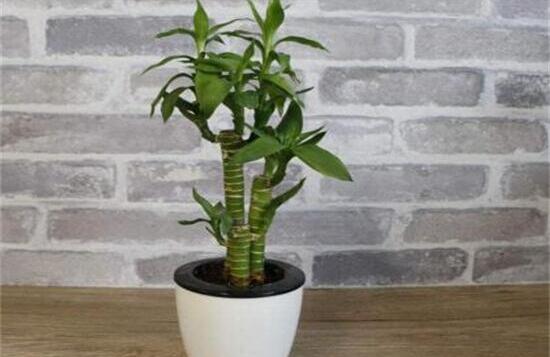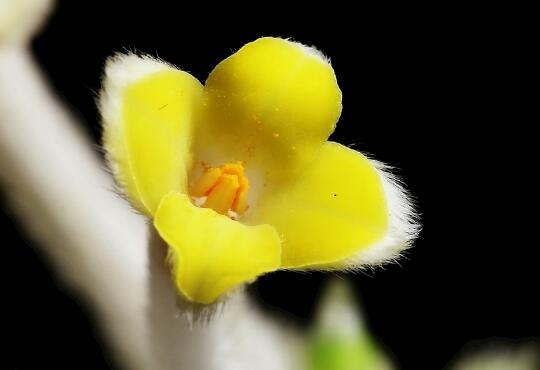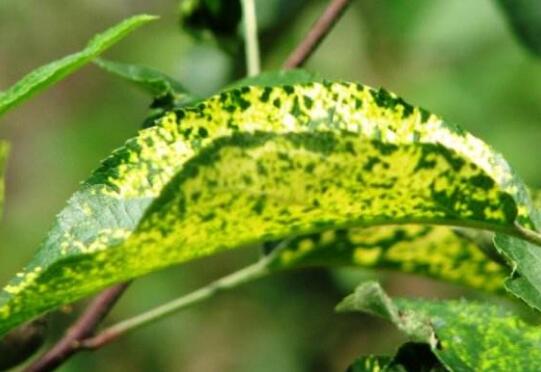How to deal with lotus bamboo worms, lotus bamboo diseases and insect pests control / leaf spot disease spraying
In indoor plant cultivation, diseases and insect pests need to be paid attention to, because their appearance will often bring a devastating blow to the plant. As a beautiful green plant, lotus bamboo is not only good-looking, but also effective, so it is often potted at home. So, in the process of breeding, lotus bamboo worms how to do? The following are several kinds of lotus bamboo pest control, let's go and have a look!
1. How to deal with the lotus bamboo worm

Lotus bamboo is tenacious and rarely infects insects, but in the case of improper maintenance and poor environment, it will also grow insects and get sick. Among them, the main diseases of lotus bamboo are leaf spot, root rot and anthracnose, and the main pests are shell insects and red spiders, which will affect the health and beauty of the plant, so they should be eliminated as soon as they are found.
II. Disease and pest control of lotus bamboo
1. The shell worm of lotus bamboo
Although lotus bamboo is not easy to infect insects, in an environment of poor ventilation and poor light, shell insects will also come to the door. The insect generally floats and attaches to the leaf surface of the plant, and the secretion pollutes the leaves, affecting the photosynthesis of the plant, resulting in wilting of the leaves and inducing coal fouling disease.
Prevention and control methods: when there are few shell insects, you can gently brush off the insects with a brush dipped in water, and then spray white vinegar to prevent them; when there are too many shell insects, you can spray 1000 times of omethoate for prevention and control, once a week for 2 or 3 times in a row.
2. Lotus Bamboo Red Spider
In addition to shell insects, under the condition of high temperature, high humidity and poor ventilation, lotus bamboo may also give birth to red spiders. The insect mainly uses mouthparts to pierce into the leaves of lotus bamboo to suck juice, which destroys the chlorophyll of the plant and causes the leaves of lotus bamboo to turn yellow and even detach.
Control methods: when individual leaves are damaged, insect leaves can be removed; when more leaves are damaged, propargite, dimethoate, Huachongjing and other drugs should be sprayed as soon as possible.
3. Lotus bamboo root rot
In the case of improper maintenance, lotus bamboo will also get sick, of which the most common is root rot. The disease generally occurs in excessive watering or poor drainage of basin soil, coupled with the occurrence of dark indoor conditions, resulting in black rot of roots and stems of lotus bamboo, as well as yellowing of lotus bamboo pillars.
Prevention and treatment: after the above diseases are found, the rotten parts of lotus bamboo are cut off, applied with sulfur powder, and then replaced with fresh culture soil and replanted.
4. Leaf spot of lotus bamboo
When indoor temperature fluctuates greatly in a short period of time, or too much watering during dormancy, lotus bamboo is also prone to leaf spot disease. The disease mainly causes harm to the lower leaves of the lotus bamboo, the diseased leaves will appear many small brown spots, in serious cases will spread throughout the leaves.
Prevention and treatment methods: when the above diseases are found, remove the diseased leaves in time and destroy them centrally in order to reduce the source of the disease; at the initial stage of the disease, the foliar surface can be sprayed with 42% gram fungus powder 3000 times, once every 5-7 days, 2 times every 3 times, which can be basically cured.
5. Anthracnose of lotus bamboo
In the prevention and control of lotus bamboo diseases and insect pests, anthracnose is also something that everyone needs to prevent. The disease easily occurs when the humidity is too high and the environment is not ventilated in the rainy season. If the leaf tip of the lotus bamboo turns black and the leaves have yellow spots, it should be suffering from anthracnose.
Prevention and treatment methods: when the above diseases are found, if it is winter and spring, the diseased leaves should be removed and destroyed in time, and the soil should be disinfected with quicklime. At the initial stage of the disease, 75% chlorothalonil 600 times or 50% thiram wettable powder 500 times can be sprayed once every 7 to 10 days, 3 times in a row.
With regard to the prevention and control of lotus bamboo diseases and insect pests, the editor has introduced this. I believe that if you encounter lotus bamboo worms or get sick again, you should know how to do it! Generally speaking, the breeding method of lotus bamboo is not difficult, as long as we take good care of it, bugs will not come to us. Finally, may your lotus bamboo grow beautifully.
How to control the long insect of double-line taro, how to control the diseases and insect pests of double-line taro / 3 insects and 2 diseases
As a beautiful foliage plant, double-line taro has colorful leaves, white, green and red are equal, looking extremely beautiful! But in indoor farming, because of environmental differences, maintenance of negligence, will encounter a lot of problems, such as long worm disease, that double-line taro long worm how to treat? The following is the pest control of double-line taro. Let's go and have a look.
First, how to control the long worm of double-line taro?
In the process of raising double-line taro, for a variety of reasons, it is inevitable to encounter the disease of long worms. Among them, the main pests are aphids, shell insects and red spiders, and the diseases are leaf spot and white silk disease, which will endanger the health and beauty of the plant. As for how to treat the double-line taro worm, we should spray it in time to prevent and cure it.
2. pest control of double-line taro.
1. Double-line taro aphids
If the double-line taro worm is found, it is likely to be an aphid, because it is the main pest of foliage plants. The insect generally appears in young leaves and newly grown buds and feeds on the juice in the leaves, resulting in yellowing of double-line taro leaves and black or yellow disease spots.
Control methods: when there are few aphids, you can take artificial control of aphids, brush off the aphids with a brush and bury them in the basin soil; when there are many shell insects, you can spray 1500 times of omethoate or 90% trichlorfon for control. Usually pay attention to reasonable watering and fertilization to improve its resistance to diseases and insect pests.
2. Double-line taro scale
When the environment is not ventilated and improperly maintained, double-line taro is also easy to produce insect bugs. The insect will attach to the leaves and absorb nutrients and water, resulting in poor growth of double-line taro, and eating taro leaves by shell insects will also cause other diseases, which will directly lead to the withering and death of double-line taro.
Prevention and control methods: when a small amount of shell insects are found, they can be manually treated with brushes; if a large number of shell insects are found, in addition to artificial insecticide, they also need to be controlled with spraying, which can be controlled by 1500 times of malathion or 1000 times of imidophos. Spray once a week, twice a week can be effectively controlled.
3. Double-line taro red spider
In addition to aphids and shell insects, red spiders are also the main pests of double-line taro. The insect often occurs when the ventilation is not good, it mainly uses mouthparts to pierce into the leaves of double-line taro to suck juice, which destroys the chlorophyll of the plant, yellowing the leaves slightly, and even falling leaves seriously, which seriously affects the ornamental.
Prevention and control methods: after discovering diseases and insects, you can use enemy killing to deal with them, and you can also spray anti-mite 25% EC 800x solution, 73% acarate 2000 times liquid and other drugs.
4. Leaf spot of double-line taro
Double-line taro is adaptable and rarely gets sick, but it can also suffer from leaf spot disease in a hot and unventilated environment. In the early stage of the disease, there are small yellow-brown spots on the leaves, and halos will appear on the edges; in severe cases, the spots will quickly spread to each branch and leaf of the double-line taro, which will eventually lead to the withering and death of the double-line taro.
Prevention and treatment methods: after the above symptoms are found, cut off all the diseased branches in time to reduce the source of the disease; then spray the relevant agents, you can choose 38% cuproloxil 800 × 1000 times liquid, or 4% fluorosilazole 1000 times liquid, spray once every other week, three times in a row can be effective.
5. White silk disease of double-line bamboo taro
In the double-line taro diseases and insect pests, white silk disease also needs everyone's attention. The disease is often serious in July and August, but it often occurs at ordinary times, often because the soil is too wet and barren. When the disease occurs, it will cause purple-brown spots on the leaves, followed by a clear white mycelium layer, and in severe cases, the plant will wither and eventually die.
Prevention and treatment methods: after the above diseases are found, fungicides such as carbendazim, Bordeaux solution, Baume sulfur mixture and other fungicides are sprayed on the stem base and substrate in time, or after the disease, the basin soil with bacteria is removed directly and sprinkled with pentachloronitrobenzene powder or lime.
With regard to the prevention and control of diseases and insect pests of double-line taro, this is the end of the introduction. I believe that if you encounter a double-line taro worm or get sick again, you should know how to do it! Generally speaking, the breeding method of double-line taro is not difficult, as long as we take good care of it, bugs will not come to us. Finally, may your double-line taro grow beautifully.
What to do with the growth of insects in Jasminum flowers? disease and pest control of Jasminum flowers / 2 insect pests 2 diseases
In the process of breeding vegetarian sweet flowers, the last thing we want to encounter is diseases and insect pests. This kind of problem is very harmful to the plant, which will not only affect its beautiful plant shape, but also lead to plant death if it is not treated for a long time. So what should I do if the Jasminum flowers grow worms? What do you need to do to control diseases and insect pests of Suxin flowers? Next, the editor will take you to learn about it.
First, what if the Jasminum flowers grow worms? find the reason.
If you want to know what to do with the growing insects of vegetarian flowers, we must first understand what kind of insects grow, so that we can deal with them pertinently, because the treatment methods of each kind of diseases and insect pests are different, and the details are described in detail below. Friends who are troubled in this respect can learn about it.
II. Disease and insect pest control of Jasminum
Red spider
Among the diseases and insect pests of Jasminum flowers, the red spider has a relatively high incidence, and its high incidence period is in the summer every year, so at this time we must pay special attention to the fact that when this kind of pest occurs, the leaves of the plant will gradually turn yellow and whiten, and if it is not treated for a long time, it will also lead to the phenomenon of plant wilting.
Control method: when we deal with the pest of red spider, we can directly use 40% diclofenac EC 1000-1500 times to spray, generally three times in a row can completely kill this pest.
Whitefly
Whitefly is such a small pest that it is difficult to detect with the naked eye. The largest whitefly is generally larger than 3mm, so the pest can only be identified by symptoms. This kind of pest mainly sucks the sap of the plant, which makes the plant lose its nutrients and wither.
Control methods: the most direct method for this pest is to use drugs for treatment, generally we can choose insect chitinase inhibition to spray on the plant, in order to get the effect of killing this pest.
Leaf spot disease
Leaf spot is a disease caused by fungi, and its high incidence period is in spring and autumn every year, so we must pay special attention in these two seasons. Leaf spot mainly harms the leaves of Magnolia officinalis, there will be many prototype disease spots on the leaves, and the disease spots will gradually expand, the shape will become irregular, it is best to lead to the gradual death of the plant.
Control methods: we can use 80% mancozeb 400-600 times to spray the diseased plants when we control the diseases and insect pests of Jasminum, which is usually sprayed once every 10-15 days, and can be cured once or twice.
Powdery mildew
Powdery mildew is a common plant disease, this disease will generally appear on the leaves, begin to appear a lot of irregular white powder, with the development of the disease will gradually become dark brown, and later will directly lead to yellow and twisted leaves.
Prevention and treatment: pull out the diseased plant in time and gather together to destroy less. Or choose 25% carbendazim wettable powder 500 times solution to spray.
- Prev

What should we do if the insect grows in fragrant flowers? pest control of fragrant flowers / 2 insect pests 2 diseases
In the process of cultivating fragrant flowers, the last thing we want to encounter is diseases and insect pests. This kind of problem is very harmful to the plant, which will not only affect the beauty of the plant, but also cause the plant to wither and die. So what should I do if the fragrant flowers grow into worms? How to control the diseases and insect pests of fragrant flowers?
- Next

5 diseases/medicine control effect quickly
In the process of breeding primrose, the last thing we want to encounter is diseases and insect pests. This kind of problem is very harmful to plants, which will not only affect the beauty of plant type, but also lead to plant death when it is serious. So how to prevent and control diseases and insect pests of primrose? The following small series takes everyone to understand
Related
- Fuxing push coffee new agricultural production and marketing class: lack of small-scale processing plants
- Jujube rice field leisure farm deep ploughing Yilan for five years to create a space for organic food and play
- Nongyu Farm-A trial of organic papaya for brave women with advanced technology
- Four points for attention in the prevention and control of diseases and insect pests of edible fungi
- How to add nutrient solution to Edible Fungi
- Is there any good way to control edible fungus mites?
- Open Inoculation Technology of Edible Fungi
- Is there any clever way to use fertilizer for edible fungus in winter?
- What agents are used to kill the pathogens of edible fungi in the mushroom shed?
- Rapid drying of Edible Fungi

